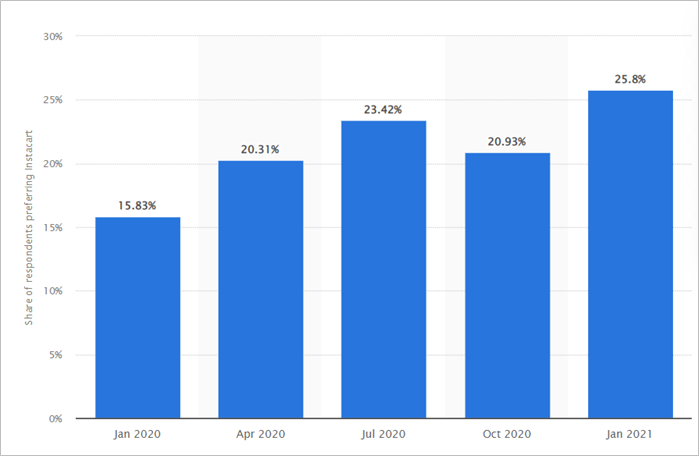The COVID-19 pandemic impacted many transitions including, but not limited to, work-from-home arrangements and home delivery services. The Coronavirus forced the need for contactless delivery as millions of Americans avoided face-to-face interactions.Through this, numerous companies in the technology and consumer products industries such as Zoom, Microsoft Teams, Skype, DoorDash, Uber Eats, Grubhub, and Postmates have experienced significant growth.
Prior to the COVID-19 pandemic, many restaurants had an established form of allowing customers to place to-go orders or had curbside pickup methods in place. The shift of consumer demand/preference created a need for the restaurants to shift their focus towards creating meals to-go that factored in greater sanitary precautions and directed more marketing towards curbside pickup and delivery. The restaurants that had already established to-go meals and/or curbside pickup had a greater advantage. Small businesses specifically struggled as their loyal customer base faced individual financial uncertainty and consumers became more conservative with spending.
During the chaos that ensued in March of 2020, services like Instacart also endured a boost. These services allowed consumers to select all groceries and household products from participating stores such as Wegmans and Shoprite and allowed the Instacart shopper and the customer to remain in contact throughout the entirety of the shopping trip. If selected products were out of stock, the customer was notified and could select to receive a refund for the item or select a replacement. Through this service, the customer had the option of home delivery or curbside pickup.This allowed consumers who were immunocompromised or had a fear of the virus to shop like how they usually would from the comfort of their homes.

The chart above details the share of consumers utilizing Instacart’s services for their grocery shopping needs. In 2021, the purchases made through Instacart accounted for 45 percent of the U.S. grocery delivery market. The only company to account for a higher percentage of the U.S. grocery delivery market was Walmart. It is also worth noting that prices for products on third-party service apps like Instacart or DoorDash can be significantly higher and there are many service fees required to be paid to utilize the services offered. “In an analysis for the New York Times, reporter Brian X. Chen compared the costs associated with different delivery apps and found that app users pay 7% to 91% more than diners who order the same food at the restaurant.” The restaurants can set their own prices for items on the third-party apps and tend to charge more to increase the profit margin and cover expenses incurred for the business to be listed on the third-party application.
Similar services have also prospered during the midst of the COVID-19 pandemic, like HelloFresh, a meal-kit company that allows individuals to order pre-cooked meals which are ready to be heated and eaten throughout the week. Many individuals who are focused on health and fitness view this as an easy alternative to meal prepping, while many others simply enjoy the convenience and view the meals as healthier and tastier than other frozen or pre-cooked meals available at a grocery store. It is crucial to note these services were available prior to the COVID-19 pandemic, but the virus outbreak accelerated the need for businesses to provide additional services such as at-home delivery or curbside pickup.
For restaurants and businesses that had these services available, the adjustments with constantly changing restrictions based on the spikes in COVID-19 cases were much more seamless, only requiring minor changes and additional marketing. Other businesses that did not have these services in place were forced to adapt or face the reality of being shut down. Zion & Zion administered a study and found that 63% of young adults use third-party delivery apps. As the restrictions surrounding the COVID-19 pandemic continue to loosen, the third-party applications will not be going away. Consumers are now used to the convenience of using these services and are willing to pay premium prices. Businesses should continue to focus marketing efforts on services that include a convenience factor for the consumer and consider if utilizing a third-party application is the next step to be taken to generate more revenue.
Author: Ashley Redfern, MBA | [email protected]
Contact Us
For more information on this topic, please contact a member of Withum’s Restaurants, Food and Beverage Services Team.



